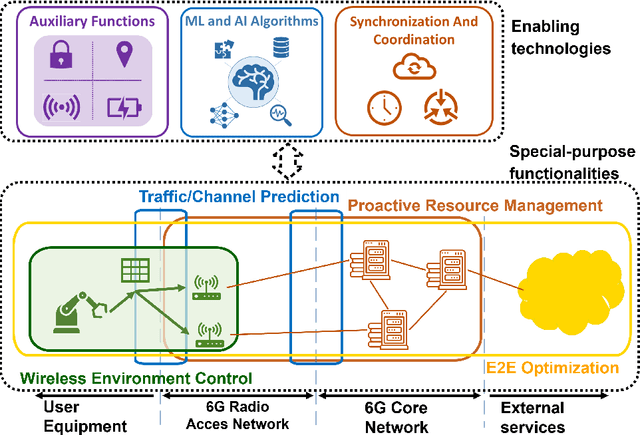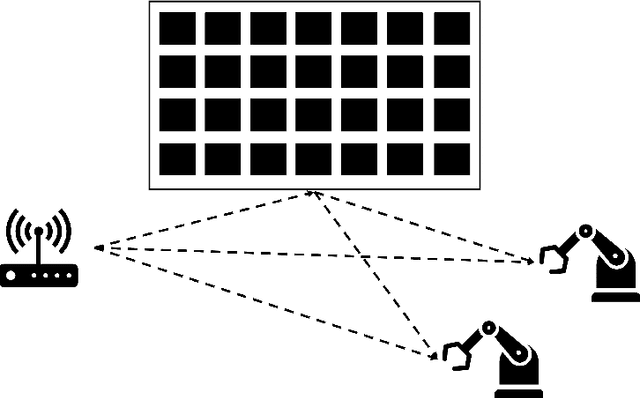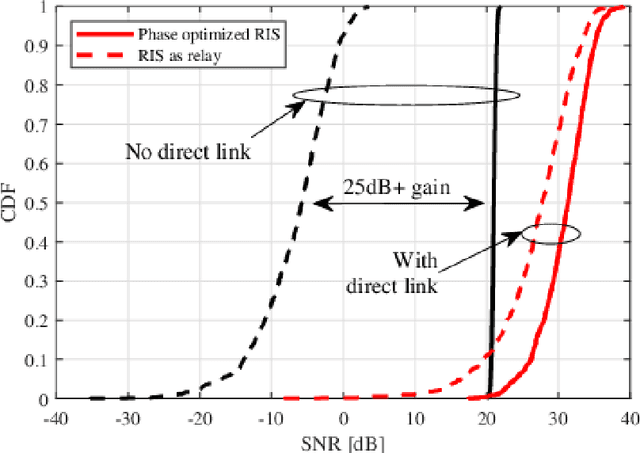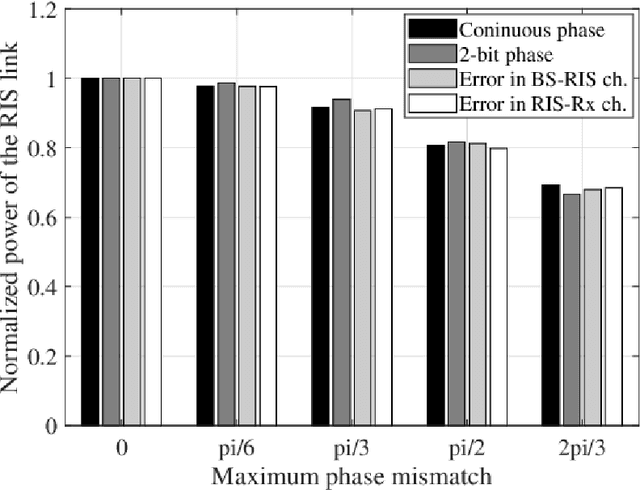Gilberto Berardinelli
AI-Assisted NLOS Sensing for RIS-Based Indoor Localization in Smart Factories
May 21, 2025Abstract:In the era of Industry 4.0, precise indoor localization is vital for automation and efficiency in smart factories. Reconfigurable Intelligent Surfaces (RIS) are emerging as key enablers in 6G networks for joint sensing and communication. However, RIS faces significant challenges in Non-Line-of-Sight (NLOS) and multipath propagation, particularly in localization scenarios, where detecting NLOS conditions is crucial for ensuring not only reliable results and increased connectivity but also the safety of smart factory personnel. This study introduces an AI-assisted framework employing a Convolutional Neural Network (CNN) customized for accurate Line-of-Sight (LOS) and Non-Line-of-Sight (NLOS) classification to enhance RIS-based localization using measured, synthetic, mixed-measured, and mixed-synthetic experimental data, that is, original, augmented, slightly noisy, and highly noisy data, respectively. Validated through such data from three different environments, the proposed customized-CNN (cCNN) model achieves {95.0\%-99.0\%} accuracy, outperforming standard pre-trained models like Visual Geometry Group 16 (VGG-16) with an accuracy of {85.5\%-88.0\%}. By addressing RIS limitations in NLOS scenarios, this framework offers scalable and high-precision localization solutions for 6G-enabled smart factories.
Multi-User Beamforming with Deep Reinforcement Learning in Sensing-Aided Communication
May 09, 2025Abstract:Mobile users are prone to experience beam failure due to beam drifting in millimeter wave (mmWave) communications. Sensing can help alleviate beam drifting with timely beam changes and low overhead since it does not need user feedback. This work studies the problem of optimizing sensing-aided communication by dynamically managing beams allocated to mobile users. A multi-beam scheme is introduced, which allocates multiple beams to the users that need an update on the angle of departure (AoD) estimates and a single beam to the users that have satisfied AoD estimation precision. A deep reinforcement learning (DRL) assisted method is developed to optimize the beam allocation policy, relying only upon the sensing echoes. For comparison, a heuristic AoD-based method using approximated Cram\'er-Rao lower bound (CRLB) for allocation is also presented. Both methods require neither user feedback nor prior state evolution information. Results show that the DRL-assisted method achieves a considerable gain in throughput than the conventional beam sweeping method and the AoD-based method, and it is robust to different user speeds.
Learning Power Control Protocol for In-Factory 6G Subnetworks
May 09, 2025Abstract:In-X Subnetworks are envisioned to meet the stringent demands of short-range communication in diverse 6G use cases. In the context of In-Factory scenarios, effective power control is critical to mitigating the impact of interference resulting from potentially high subnetwork density. Existing approaches to power control in this domain have predominantly emphasized the data plane, often overlooking the impact of signaling overhead. Furthermore, prior work has typically adopted a network-centric perspective, relying on the assumption of complete and up-to-date channel state information (CSI) being readily available at the central controller. This paper introduces a novel multi-agent reinforcement learning (MARL) framework designed to enable access points to autonomously learn both signaling and power control protocols in an In-Factory Subnetwork environment. By formulating the problem as a partially observable Markov decision process (POMDP) and leveraging multi-agent proximal policy optimization (MAPPO), the proposed approach achieves significant advantages. The simulation results demonstrate that the learning-based method reduces signaling overhead by a factor of 8 while maintaining a buffer flush rate that lags the ideal "Genie" approach by only 5%.
Power Efficient Cooperative Communication within IIoT Subnetworks: Relay or RIS?
Nov 19, 2024Abstract:The forthcoming sixth-generation (6G) industrial Internet-of-Things (IIoT) subnetworks are expected to support ultra-fast control communication cycles for numerous IoT devices. However, meeting the stringent requirements for low latency and high reliability poses significant challenges, particularly due to signal fading and physical obstructions. In this paper, we propose novel time division multiple access (TDMA) and frequency division multiple access (FDMA) communication protocols for cooperative transmission in IIoT subnetworks. These protocols leverage secondary access points (sAPs) as Decode-and-Forward (DF) and Amplify-and-Forward (AF) relays, enabling shorter cycle times while minimizing overall transmit power. A classification mechanism determines whether the highest-gain link for each IoT device is a single-hop or two-hop connection, and selects the corresponding sAP. We then formulate the problem of minimizing transmit power for DF/AF relaying while adhering to the delay and maximum power constraints. In the FDMA case, an additional constraint is introduced for bandwidth allocation to IoT devices during the first and second phases of cooperative transmission. To tackle the nonconvex problem, we employ the sequential parametric convex approximation (SPCA) method. We extend our analysis to a system model with reconfigurable intelligent surfaces (RISs), enabling transmission through direct and RIS-assisted channels, and optimizing for a multi-RIS scenario for comparative analysis. Simulation results show that our cooperative communication approach reduces the emitted power by up to 7.5 dB while maintaining an outage probability and a resource overflow rate below $10^{-6}$. While the RIS-based solution achieves greater power savings, the relay-based protocol outperforms RIS in terms of outage probability.
Unsupervised Graph-based Learning Method for Sub-band Allocation in 6G Subnetworks
Dec 13, 2023Abstract:In this paper, we present an unsupervised approach for frequency sub-band allocation in wireless networks using graph-based learning. We consider a dense deployment of subnetworks in the factory environment with a limited number of sub-bands which must be optimally allocated to coordinate inter-subnetwork interference. We model the subnetwork deployment as a conflict graph and propose an unsupervised learning approach inspired by the graph colouring heuristic and the Potts model to optimize the sub-band allocation using graph neural networks. The numerical evaluation shows that the proposed method achieves close performance to the centralized greedy colouring sub-band allocation heuristic with lower computational time complexity. In addition, it incurs reduced signalling overhead compared to iterative optimization heuristics that require all the mutual interfering channel information. We further demonstrate that the method is robust to different network settings.
On the required radio resources for ultra-reliable communication in highly interfered scenarios
Jun 10, 2023Abstract:Future wireless systems are expected to support mission-critical services demanding higher and higher reliability. In this letter, we dimension the radio resources needed to achieve a given failure probability target for ultra-reliable wireless systems in high interference conditions, assuming a protocol with frequency hopping combined with packet repetitions. We resort to packet erasure channel models and derive the minimum amount of resource units in the case of receiver with and without collision resolution capability, as well as the number of packet repetitions needed for achieving the failure probability target. Analytical results are numerically validated and can be used as a benchmark for realistic system simulations
Power Control for 6G Industrial Wireless Subnetworks: A Graph Neural Network Approach
Dec 30, 2022Abstract:6th Generation (6G) industrial wireless subnetworks are expected to replace wired connectivity for control operation in robots and production modules. Interference management techniques such as centralized power control can improve spectral efficiency in dense deployments of such subnetworks. However, existing solutions for centralized power control may require full channel state information (CSI) of all the desired and interfering links, which may be cumbersome and time-consuming to obtain in dense deployments. This paper presents a novel solution for centralized power control for industrial subnetworks based on Graph Neural Networks (GNNs). The proposed method only requires the subnetwork positioning information, usually known at the central controller, and the knowledge of the desired link channel gain during the execution phase. Simulation results show that our solution achieves similar spectral efficiency as the benchmark schemes requiring full CSI in runtime operations. Also, robustness to changes in the deployment density and environment characteristics with respect to the training phase is verified.
A Functional Architecture for 6G Special Purpose Industrial IoT Networks
Jul 01, 2022



Abstract:Future industrial applications will encompass compelling new use cases requiring stringent performance guarantees over multiple key performance indicators (KPI) such as reliability, dependability, latency, time synchronization, security, etc. Achieving such stringent and diverse service requirements necessitates the design of a special-purpose Industrial Internet of Things (IIoT) network comprising a multitude of specialized functionalities and technological enablers. This article proposes an innovative architecture for such a special-purpose 6G IIoT network incorporating seven functional building blocks categorized into: special-purpose functionalities and enabling technologies. The former consists of Wireless Environment Control, Traffic/Channel Prediction, Proactive Resource Management and End-to-End Optimization functions; whereas the latter includes Synchronization and Coordination, Machine Learning and Artificial Intelligence Algorithms, and Auxiliary Functions. The proposed architecture aims at providing a resource-efficient and holistic solution for the complex and dynamically challenging requirements imposed by future 6G industrial use cases. Selected test scenarios are provided and assessed to illustrate cross-functional collaboration and demonstrate the applicability of the proposed architecture in a wireless IIoT network.
* 11 pages, 5 figures
 Add to Chrome
Add to Chrome Add to Firefox
Add to Firefox Add to Edge
Add to Edge